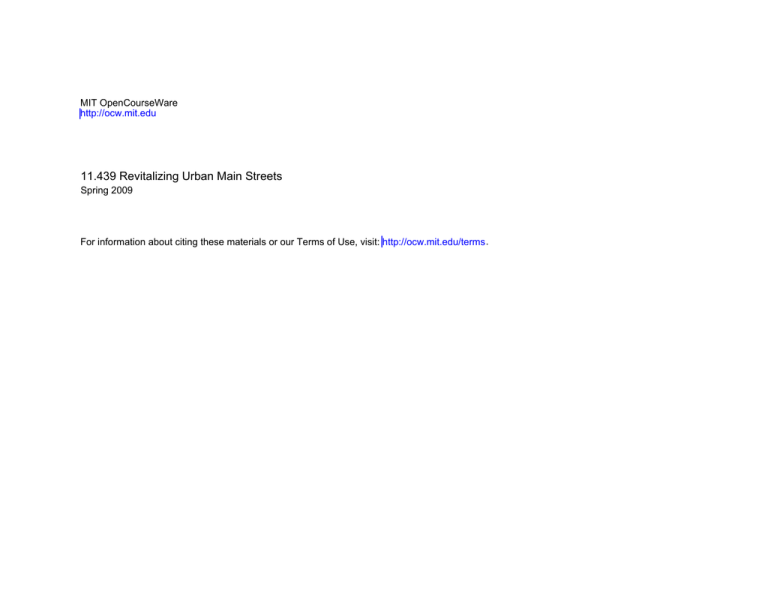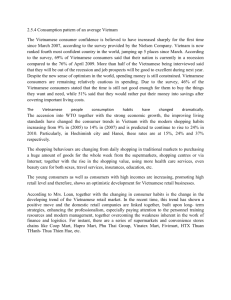11.439 Revitalizing Urban Main Streets
advertisement

MIT OpenCourseWare http://ocw.mit.edu 11.439 Revitalizing Urban Main Streets Spring 2009 For information about citing these materials or our Terms of Use, visit: http://ocw.mit.edu/terms. A2E Ethnic Retail Analysis Karl Seidman & Graduate Student Presentation Overview Research Objectives and Methods New Orleans Village de L’Est Analysis and findings Retail business opportunities and options Discussion East Biloxi Analysis and findings Retail business opportunities and options Discussion Best ways to grow local ethnic retail firms & jobs Next steps Research Objectives Identify promising market opportunities to for business start-ups or existing store expansion Survey customers on shopping habits and preferences Assess local interest and capacity to pursue opportunities Identify options to capitalize on market opportunities Business models Business development role and services Methods Assess demand by consumer segment for different retail products and businesses Secondary data and local knowledge Estimate sales of existing retail stores Compare demand and supply to identify under supplied retail businesses Customer surveys Interview local business development staff on retail conditions, trends, opportunities Summarize business development models used in community economic development Methods Demand Side Analysis Supply Side Analysis Define market segments Estimate size & spending for each segment Sum spending by business type Local capacity Inventory local stores & competition Informs local market share of spending Market Under- Market Demand Supplied Stores Supply Business Opportunities Estimate sales by each store type Preferences & Competition Village de L’Est Market Demand Three Key Segments Local households 1,857 Vietnamese and 625 other households Estimated annual income of $122 million Regional Vietnamese-American households 3,167 households $223 million in annual income Area employees Over 2,900 workers in industrial area Estimated local spending: $5.7 million yearly Tourists not yet source of local demand Village de L’EST Retail Spending by Product and Customer Segment ($ millions) Product Category Local Residents Reg Viet Workers Residents Total $10.02 $17.17 $.73 $27.92 Eating out $6.96 $11.82 $4.39 $23.17 Housekeeping Supplies $1.71 $3.12 $.15 $3.48 Personal Care Products $1.59 $2.90 $.15 $4.64 Clothing $4.89 $9.14 --- $14.03 Home Furnishings $4.27 $7.80 --- $12.07 Liquor & Tobacco $2.32 $4.01 $.29 $6.62 Food at home Village de L’Est Retail Supply Supply 50 stores with 103,000 square feet1 26 are food related: 1 $21.75 million in estimated sales 58% of total space: 7 grocery stores 4 convenience 10 restaurants Store Type Estimated Local Sales Grocery $7.94 million Convenience $1.20 million Bars & Cafes $1.32 million Restaurants $4.01 million Pharmacies $1.07 million Furniture $1.29 million Other $4.92 million Store sizes estimated based on averages for store type Village de L’Est Retail Competition Moderate competition in groceries Three competing pharmacies within 5 minutes Clothing: Strong regional but few local competitors Three malls in Metairie & Gretna 15 + miles 7 department stores and 70+ clothing stores Several Wal-Mart stores 12 to 15 miles away Home Furnishing: 1 major supermarket within 5 minute drive 3 other independent grocers within 5 to 6 miles Several Asian/Vietnamese groceries on West Bank Near by Home Depot Multiple stores in Slidell and Chalmette, West Bank malls A dozen Vietnamese restaurants in West Bank and elsewhere in New Orleans Estimating Sales by Store TypePreliminary Use market share estimates for each segment: Local Vietnamese residents: 60% market share for groceries,40%-dining, 50% to 75% other convenience items, 20% for clothing and home furnishings. Non-Vietnamese: 20% groceries, 20% of dining, 50% other convenience items, 20% clothing & home items Regional Vietnamese population: 25% for groceries and eating out,5% for clothing and home furnishings Workers: 75% of dining, 25% for convenience items Allocate product spending across store types Groceries: 61% in supermarkets, 12% independent grocers, 5% convenience stores, 10% mass merchandisers, 12% other Village de L’Est: Local Spending by Key Store Types Store Type Supermarket Independent Food Convenience Estimated Local Demand $7.0 million $1.23 million $933,000 Restaurants Clothing Stores Home Furnishings $8.77 million $716,000 $669,000 Pharmacy $1.43 million Village de L’Est Findings: Undersupplied Stores Store Type Grocery Restaurants Demand Supply Support Sales Gap SQ FT $9,164,000 $7,575,000 $1,589,000 5,100 $8,771,000 $5,329,000 $3,442,000 18,100 Clothing $716,000 $605,000 $111,000 740 Home Furnishing $669,000 $1,291,000 ($622,000) 0 Pharmacy/ Drug Store $1,432,000 $1,071,000 $361,000 1,200 Village de L’Est: Consumer Surveys and Interviews Customers shop often for multiple goods and services Businesses catering to diverse customers are doing well Restaurants and services for area workers Grocery stores and restaurants serving Latinos Most new business proposals are service related: Majority of local & regional customers shop at least weekly Primary shopping area for > 75% of local residents for Vietnamese groceries, restaurants, and personal services Main area for ½ of reg. shoppers for Viet dining & groceries Foot massage, dance studio, hair salon, real estate Area rated well for quality & selection of Viet goods but got low marks for cleanliness, appearance and safety Strong customer interest in more: Large Vietnamese supermarkets Vietnamese and American restaurants Super centers (e.g., Wal-Mart) Village de L’Est Findings: Local Capacity and Preferences New generation of younger residents interests in starting businesses MQVN technical assistance capacity and connections to lenders Local business association Business new financial management and marketing expertise Need to improve area image, especially around public safety and appearance Area’s “brand” is strongest as Vietnamese food destination Consumer desire for more Vietnamese retail and large format retail Village de L’Est Findings: Business Opportunities Restaurants Family-oriented Vietnamese American chain restaurants and fast food Café offering premium coffee and social gathering place Expansion of grocery stores to attract regional Vietnamese customers Services for local residents and workers Laundry/dry cleaning, banking, day care Stores catering to younger residents Fitness center, bridal shop, Café/boba/Vietnamese sandwich shop Small Retailer Financial Performance Home Furn. Elect. & Food & Appl. Bev. Rest. Per Serv. /Laundry Avg. Sales 236,000 556,000 754,000 623,000 309,000 Avg. Assets 143,000 124,000 131,000 124,000 86,000 Prop & Equip. 26,000 17,000 34,000 54,000 36,000 Net Worth 50,000 39,000 41,000 35,000 28,000 4.1% 6.5% 2.8% 6.5% 10.1% 23% 30.5% 18.1% 34.5% 38.2% Profit % Return on Assets Business Development Options Direct individual business start-ups to promising opportunities Intensive training on restaurants, child care Work with existing businesses to expand Improve performance of existing stores Shared food court or marketplace for smaller scale enterprises (Mercado) CDC-initiated or jointly owned enterprise Retail/shopping center development Coffee shop, child care center Potential for larger scale destination retail Continue marketing and market development work Discussion Do assumptions and results seem right? Reaction to retail business opportunities? What are best options to: Promote new businesses? Stabilize and grow existing businesses? What are ethnic retail development priorities and next steps for A2E? Biloxi Market Demand Four Key Segments 7,000 local population Regional Vietnamese-Americans 5,928 population; 1,793 households Estimated total income of $69.6 million 17,900 area employees, pre-Katrina 394 Vietnamese households ; 2,143 other households Estimate total annual income of $67.7 million Estimated $22 million annual local spending Biloxi tourists $1 billion annual spending $337 million for meals and shopping Biloxi: Retail Spending by Product and Customer Segment ($ millions) Product Category Food at home Local Resid. Reg Viet Workers Resid. Tourists Total $5.96 $6.12 $4.50 $0 $16.56 Eating out $3.59 $3.69 $13.4 $224 $244.92 Housekeeping Supplies $.948 $.97 $.89 $0 $2.82 Personal Care Products $.880 $.90 $.89 $0 $2.68 Clothing $2.71 $2.78 $0 $0 $5.49 Home Furn. $2.17 $2.23 $0 $4.40 Liquor & Tobacco $1.29 $1.32 $1.79 $4.40 Gen shopping $112.6 $112.6 East Biloxi Retail Supply 14 stores with 28,000 square feet $6 million estimated total sales Store Type Independent Food 7 are food related: Convenience 67% of total Restaurants space: 1 grocery store 4 convenience 3 restaurants Estimated Local Sales $934,000 $1,780,000 $1,460,000 Pharmacy $621,000 Liquor $934,000 Other $849,000 East Biloxi Retail Competition Strong competition in grocery Many competing Pharmacies Clothing: Edgewater Mall within 6 miles 4 department stores and 26 clothing stores 2 more large malls in Gulfport (17 miles ) Less competition in home furnishings 2 major supermarkets with 10 minute drive 4 other Asian grocers in region; 2 local grocers 1 major and 1 smaller store within 5 miles Dept stores and Home Depot 7 miles away 3 Vietnamese and 7 other Asian restaurants Estimating Sales by Store Type Use market share estimates for each segment: Local Vietnamese residents: 50% for groceries, 25% to 50% other convenience items, 10% for clothing and 15% for home furnishings, 20% dining Local Non-Vietnamese: 25% groceries, 10% of dining, 25% to 50% convenience items, 10% clothing, 15% home furn. Regional Vietnamese population: 20% for groceries, 20% dining, 5% for clothing, 10% home furnishings Workers: 10% of dining; 25% of convenience items Tourists: 1% of dining Allocate product spending across store types Groceries: 61% in supermarkets, 12% independent grocers, 5% convenience stores, 10% mass merchandisers, 12% other Retail Spending Key Store Types Store Type Supermarket Independent Food Convenience Restaurants Estimated Local Demand $3,150,000 $532,000 $486,000 $4,737,000 Clothing Stores $205,000 Home Furnishings $337,000 Biloxi Findings: Undersupplied Stores Store Type Demand Supply Sales Gap Support SQ FT Grocery $4,168,000 $2,714,000 $1,454,000 4,700 Restaurants $4,737,000 $1,460,000 $3,277,000 16,400 Clothing $205,000 $0 $205,000 1,400 Home Furnishing $337,000 $0 $337,000 2,100 Pharmacy/ Drug Store $635,000 $621,000 $14,000 0 Biloxi: Consumer Surveys and Interviews Shift of residents and businesses to D’Iberville and Ocean Springs Survey customers use area for grocery and restaurants Health businesses and restaurants doing well New business proposed: Restaurant, bar, nightclub, real estate development Good potential seen for more restaurants Perception challenges for Oak Street Safety, sense that area is not active Customers rate area well for quality and selection of Vietnamese goods and services Strongest customer interest in more grocery stores/restaurants Biloxi: Local Capacity and Preferences Businesses face multiple challenges High costs, shifting market, perception of area Entrepreneurs lack business expertise and business development resources limited Need for business planning, finance and marketing assistance Area’s “brand” is strongest as Vietnamese food destination Consumer desire for more retail diversity More American and Vietnamese options More variety of stores and restaurants Biloxi Findings: Business Opportunities Restaurants present strongest opportunity Some potential for grocery store Larger size and good quality Comparison retail difficult but may be feasible with careful business planning Largest level of spending and retail gap Serves many market segments Builds on area strength Furniture/home supply –requires large spaces Clothing least feasible with area malls Non-retail: construction and development Business Development Options Options Direct start-ups to most promising businesses Target successful existing businesses to expand or open start new stores Training on restaurant/grocery store planning and operations Obtain food service concession in casinos Area marketing and improvements Partnerships to attract tourists Expand geographic focus to address shift to D’Iberville and Ocean Springs Food court for small fast food enterprises CDC-initiated or jointly owned enterprise Shopping center development Small Retailer Financial Performance Home Furn. Elect. & Food & Appl. Bev. Rest. Per Serv. /Laundry Avg. Sales 236,000 556,000 754,000 623,000 309,000 Avg. Assets 143,000 124,000 131,000 124,000 86,000 Prop & Equip. 26,000 17,000 34,000 54,000 36,000 Net Worth 50,000 39,000 41,000 35,000 28,000 4.1% 6.5% 2.8% 6.5% 10.1% 23% 30.5% 18.1% 34.5% 38.2% Profit % Return on Assets Discussion Do assumptions and results seem right? Reaction to retail business opportunities? What are best options to: Promote new businesses? Stabilize and grow existing businesses? Strengthen area image and marketing? What are ethnic retail development priorities and next steps for A2E?




